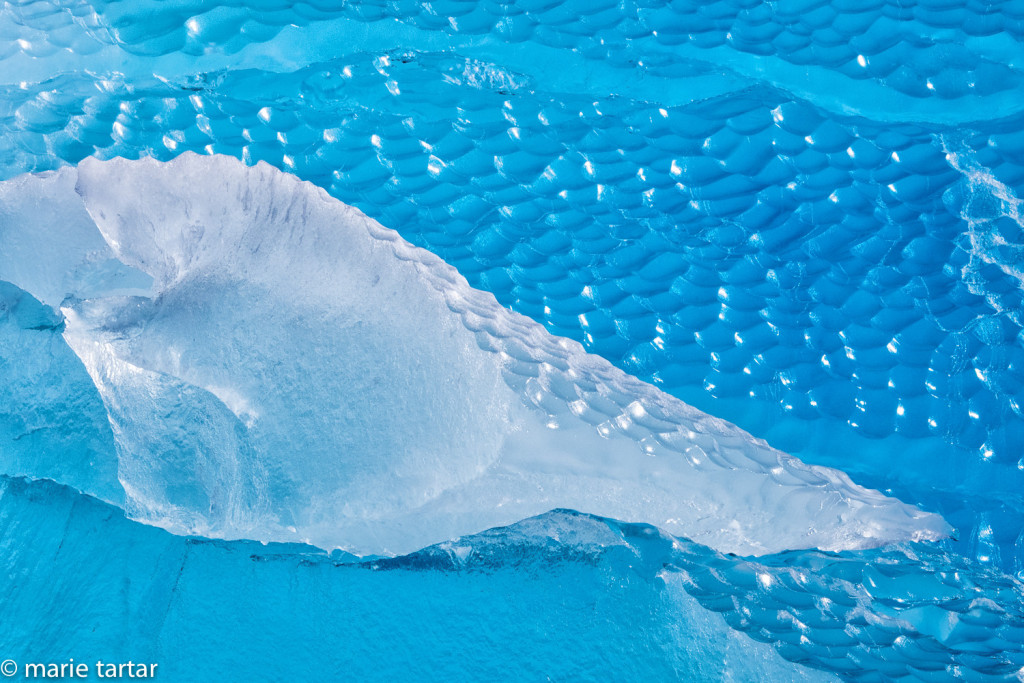
Friday, January 30-Sunday, February 1, 2015
What do love and romance have to do with Antarctica? Actually, mating and fidelity could be considered a central theme of Antarctica, both in general and for us in particular. This was our second, long-awaited trip. After disembarking in 2003 from our prior trip 12 years before, after which we immediately turned to each other in “We have to come back” mutual agreement, we decided the best way to celebrate 25 years of marriage was to repeat one of our all-time favorite trips.
Extending our early February trip with a side trip to Patagonia would even take us through Valentine’s Day. What better way to sidestep overtaxed restaurants than to have an extra-long traveling Valentine’s Day, starting on washboard dirt roads from Torres del Paine National Park in Patagonia, proceeding to paved roads from Puerto Natales to Punta Arenas, leading to the series of 3 flights to retrace our steps home? Call me a romantic, but I found something appealing in the notion of us hurtling through an endless night , side by side in sleeper seats, as though we were astronauts in cryogenic suspension orbiting silent space. In our case, this would be the longest leg of the journey, 9 hours overnight from Santiago, Chile.
We weren’t the only travelers to Antarctica to be celebrating commitments: on our ship were 2 newlywed couples on their honeymoons, Tara and Bernard from Cairo, and Ted and Yazi from NYC. We even witnessed a wedding ceremony in Antarctica. Serenaded by pungent Gentoo penguin colonies, trip organizer Kevin wed his bride Debra, with the ship’s captain officiating and the boatload of Luminous Landscape passengers on looking.
Penguins, the marquee animal of Antarctica, are themselves models of fidelity: mating for life, they return each year to their birthplace, relocating their partners by their unique trilling calls, driven by a biological imperative to mate, tend their nests and nurture their chicks, while the fishing is plentiful in the Antarctic summer.
Our actual 25th wedding anniversary was the preceding summer, but going on our anniversary wasn’t an option, unless we wanted to overwinter. Going 7 months later, in the Antarctic summer, gave us more time to accumulate the considerable funds necessary. Less romantic perhaps, but a practical choice and reliably fun, was our decision to room with our frequent travel companion, our photographer friend Greg: rooming together in a triple room (actually a quad) would save each of us $2000, and save Greg from roommate potluck. We introduced Greg as our butler, lest our fellow passengers think we were inaugurating the next 25 years of marriage as a ménage à trois.
Actually, the nature of the trip meant intimacy was about the last thing on our minds. Traveling to such a photogenic place during the long days of Antarctic summer with a hardcore group of photographers meant rising in the wee hours for the sunrise and staying up late for the setting sun. The long days and changing scenery, coupled with the need to download images, edit, “huddle” with other guests and photo pros, attend briefings and presentations, meant finding the time to take a shower was difficult. I found myself repeatedly falling asleep after lunch editing images, electing a brief catch up nap over editing, showering and other more elective activities.
As usual, the preparation for this even-more-than-usually gear-intensive trip was accompanied by anxiety over what and how much camera gear to bring and what to wear to be warm enough, yet mobile. This was coupled with constraints imposed by the actual trip we selected: a dedicated photography trip with Luminous Landscape, flying to Antarctica, instead of the usual multiple days at sea over the infamous Drake Passage between the inferior tip of South America and the Antarctic Peninsula. By flying, we swapped 2 days each way, in potentially rough seas, for a 2 hour flight. In return, we gained more weather dependency and a strict weight limit of 20 kg (44 pounds) per person, INCLUDING hand luggage, photography gear and computer. I was mostly reassured by learning, before making our deposits, that in 10 years of flights to Antarctica like this, only 1 trip had been unsuccessful. That seemed a reasonable track record. An extra day in Punta Arenas, at the southern tip of the South American continent, had been factored in as a weather delay day.
Saturday, January 31, 2015: A day in Santiago, Chile
We met up with Greg in Houston in the evening, with enough time for dinner before boarding our evening flight. Our foodie friend had texted an airport dining suggestion the week before, a recommendation from his brother Mike. Conveniently, Pappadeaux Seafood Kitchen was located near our United departure gate. Our gregarious waitress saved me from myself and warned me away from a triple order of the Maryland crab cakes, steering me toward a double order with a salad (Caesar). This was a good choice, as the crab cakes were delicious but extraordinarily rico!
We were sufficiently full that we were able to resist having an immediate delectable second airline dinner after boarding. Mileage-secured coveted seats in business with fully reclining seats ensured we were all in reasonable shape on arriving in Santiago next morning.
Santiago was warm already as our cabbie whisked us into the city center to Hotel Plaza San Francisco. While freshening up in the gym, I squeezed a plastic travel-size bottle of lotion a little, urging the contents out, only to have it fracture and baptize the dressing room in a spectacular Dali-esque arc. Now joined by Stephen, a fellow passenger we met in the airport, we hit the streets in search of La Chascona, the Santiago home of Nobel Prize-winning poet Pablo Neruda, in the nearby neighborhood of Bellavista. Named for the unruly red hair of his third wife, Matilde Urrutia, it was their secret love nest when they first become involved and their home together after marrying. Begun in 1953, it sprawls up a terraced parcel, and consists of a series of rooms and gardens built in stages. It was interesting as a mid-century period piece, and the home of a fascinating couple at the center of artistic and political Chilean life, entertaining artists, literati, and politicians from the 1950s to the 1970s. Neruda was an inveterate collector of folk art, paintings and books, and his residences (there are 3 which can be visited, one in Valparaiso, La Sebastiana, another south of Valparaiso, Isla Negra and La Chascona) reflect this. The artwork includes works depicting women by French Cubist artist, Fernand Leger, including a ceramic of Marianne, the symbol of France. One of the portraits of Matilde is by Neruda’s friend Diego Rivera. Photography isn’t permitted of the interior-que lastima! Evidently, Neruda was a Francophile-in addition to the Legers, there were 2 Art Deco bars from Parisian bistros installed in 2 different entertaining spaces. He spent several extended periods in France, including a stint as the Chilean ambassador to France. The furniture also includes mid-century pieces by Italian designer Piero Fornasetti.
La Chascona itself was the scene of dramatic events. Neruda’s death in September 1973 occurred only 12 days after the Pinochet-led military coup that overthrew president Salvador Allende. The house was vandalized and flooded. Matilde insisted on having the funeral at the house, requiring placement of wooden planks over the mud to bring the body into the house.
Foodies never leave dinner to chance. We’ve shared many memorable multi-course gastronomic extravaganzas with Greg, from Tetsuya in Sydney to Mozaic in Ubud, Bali, to the most recent, Dill in Rekjavik, Iceland. My selection of Boragó derived from Internet descriptions of the chefs foraging for unique tastes of Chile. We chose the earliest option, 8 pm, evidently the blue-haired hour in Santiago, with bookings available until 11 pm! (We had noticed we were practically alone at our lunch restaurant at 1 pm, with the restaurant filling up progressively and hitting stride about 3-4 pm).
We could elect 6 or 10 courses, with or without drink pairings, either juices or wines. We opted for 10, with wine pairings (the last actually being beer), after starting with a brilliantly scarlet version of pisco sours. As for the food, it was gorgeously presented, sometimes on rocks, sometimes in miniature trees. Molecular manipulation was definitely at work, as in our final (of 3) desserts, a menthol life-saver shaped wafer that we were instructed to pop into our mouths quickly, causing puffs of vapor to materialize from our mouths.
Steve and Greg cracked up at the description of one of the meat dishes, which encapsulated the cow lifecycle, characterizing it as the ultimate traif (non-kosher) dish. Evidently, the veal being served was accompanied by sides prepared with milk and cheese from the mother, all alongside fragrant branches of evergreens from the region.
Sunday, February 1, 2015: Do we stay or do we go now?
Checking in to the Cabo de Horno hotel in Punta Arenas, I overheard another passenger, Jonathan, refer to the upcoming briefing and “the situation.” The “situation” turned out to be a scenario I had literally never considered as a realistic possibility: not getting out. Which is exactly what had been the fate of the prior group, they never made it to Antarctica at all. In fact, the very day of our arrival, the instructors had made not one, but two, attempts to fly to Antarctica, only to be turned backed due to fog, once after 2 hours, when they were nearly there. I could only imagine how frustrating the preceeding week must have been for the participants, waiting day after day, unable to wander very far lest a narrow window of opportunity open. They were provided with cellphones, and became more familiar with the streets of Punta Arenas than they ever dreamed possible.
We were lucky to be on the second of the 2 back-to-back trips. Ordinarily, we would have chosen the first, further away in time from the Sedona Film Festival we always attend the final week in February. But, once Greg decided to come, no triples were available on the first departure, so we took the last triple on the second. Greg, our former butler and now our good luck charm, kept us from being on the trip that was skunked!
At our afternoon orientation, we were given encouraging news: the weather situation was improving. We would have an instructional seminar at 9:30 the next morning and would have more up to date information then, but leaving the following day was anticipated.
By dinner, at a nearby historic hotel, we were given a wildly encouraging update: prepare for departure from the hotel at 7:15 am for transport to the airport. We were reluctant to celebrate yet, until we actually landed.
Greg and I sped the flight up by watching a gripping film on his laptop, “Locke.” All of the action took place inside Locke’s BMW, as he takes and receives calls, his personal and professional life unraveling with each passing minute. He addresses his demons by talking aloud to his absent father. The acting by Tom Hardy was amazing, with all of the other actors heard only as disembodied voices on the phone.
A cheer went up as our plane, suited for short runways, actually touched down-we made it! A group who had been stranded in Antarctica with no plane to fetch them greeted us with waves and cheers.
Our first day in Antarctica was occupied with lunch, being in transit, emergency evacuation drills, all of the first day orienting to a new boat procedures.
Tuesday, February 3, 2015
What a start! We spent the sunny, calm, windless morning in zodiacs cruising Cierva Cove.
With Morton driving and instructor Jackie providing running commentary, Steve, Greg, Ted, Yazzy, Nozomi, Drew and I initially had a less full than usual zodiac, being the last to board. We had barely settled in front of a sculptural iceberg when Morton received a call on his walkie-talkie that another zodiac’s motor had conked out and we headed over to pick up 2 more passengers. Once they were on board, we headed into the slush, which crunched against the rubber hull of the zodiac.
We were enclosed in a rim of snowy white peaks, with icebergs punctuating the brash ice, impeding rapid forward motion.
We slowly made our way to an iceberg on which a lone Waddell seal lazily stirred, occasionally raising its head to regard us, curiously, or perhaps indifferently.
We crept forward without talking, poised on bended knees, elbows bolstered on the gunnels of the inflatable, rat-rat-a-tat rapid frame rates at the ready each time the giant regarded us.
From there, it was on to an even more entrenched ice floe, on which a solitary, more fearsome creature flopped: the leopard seal. Although this specimen did not display them for us, we knew the leopard seal has terror-inspiring teeth and an aggressive reputation.
In fact, later that day in the panorama lounge we saw what Art Wolfe and his zodiac companions had witnessed: a leopard seal flinging a penguin around in a bloody frenzy, in an effort to separate the hapless creature from its furry skin. I was surprised to learn later that leopard seals actually derive the bulk of their calories from krill. Antarctic krill (Euphausia superba), a shrimp-like crustacean, is the underpinning food source of Antarctica, with huge quantities being consumed by creatures ranging in size from penguins to whales.
While suiting up for the afternoon’s planned shore landing, the “landing aborted” announcement boomed over the loudspeaker: too windy to safely launch. So on to Plan B, an evening cruise in Lemaire Channel for the sunset and full moonrise.
Wednesday, February 4, 2015 was a very long day, beginning with an early call at 4:30 am for the sunrise in Lemaire Channel. Out on the frosty deck, my camera didn’t function (the battery died overnight, although I tested it the night before). With the light changing fast, I requisitioned the other X-T1 on Steve’s shoulder.
Heading out in the Zodiacs before breakfast for a cruise through the sculptural icebergs of Pleneau Bay was cold but drop-dead gorgeous.
I was frozen by the time we returned for breakfast and dreaming up plans for a luxury innovation for a zodiac: heated seats.
Later morning, we were divided into 2 groups, with half going ashore and the other half on a zodiac cruise. Leopard seals were abundant.
We could not avoid smelling the sharp pungency of the krill ladened poop of penguins on nests. Most of these penguins are Adelies. They are a sorry looking bunch, white bellies stained rusty-red by contact with krill-infused poop.
The landing was onto a snow-covered slope, with rocky patches, mildly tricky footing, enough so that Steve (whose back was acting up) declined the afternoon excursion, also a snow-covered landing.
I conked out after lunch, over my computer while editing images, barely rousing in time to head out on a 2-part shore excursion, first to Wordie House, a UK Antarctic Heritage Trust property, a wooden shack that once housed 6 early British scientists.
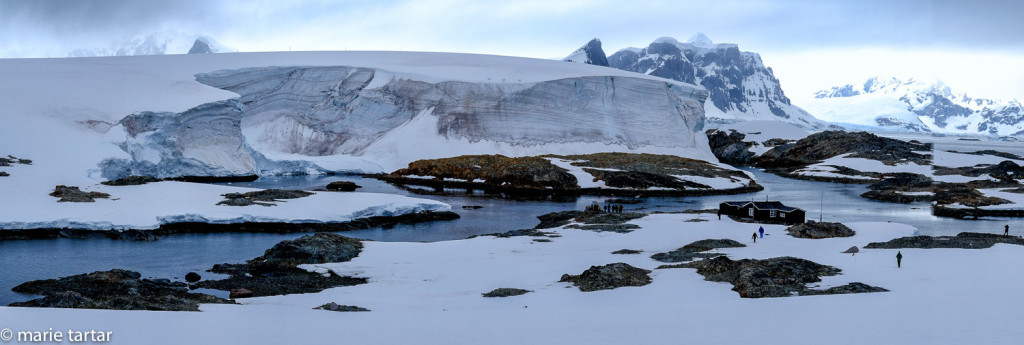
Wordie House (right) once housed British scientists and is now maintained as a UK Antarctic Heritage Trust property
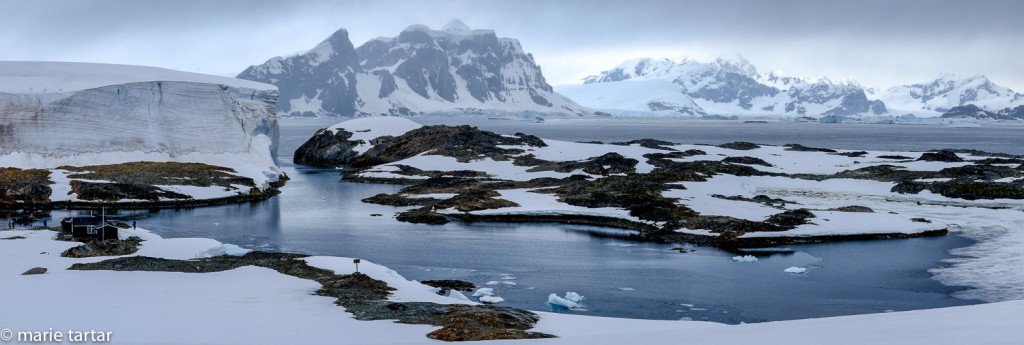
Wordie House (left) is named for the chief scientific officer on Shackleton’s 1914-17 expedition; a wooden sign reads “British Crown Land”
Not far away is Vernadsky, a former UK scientific station, sold by the Brits in a cost-saving move, to Ukraine. It houses the “Southernmost Souvenir Shop on the Earth” and a bar, which at the time of our visit, was out of vodka.
Before and during dinner in the Lemaire channel, humpback whales were actively feeding all around us.

Humpbacks were plentiful, although one downside of shooting with the Fuji X-T1 was I really didn’t have a long enough lens for capturing the more distant feeding behavoir
After dinner, the men reported to the Panorama Lounge for the bachelor party, while the bachelorette party in the library took on the air of a crafts fare, with fabric and netting being cut up for headdresses and other adornments for the following morning’s nuptials between trip organizer Kevin and his fiancé Debra.
Thursday, February 5, 2015
Neko Harbor in the morning was a spectacular setting for Kevin and Debra’s delayed wedding. They had planned to be married during the ill-fated first trip. For the occasion, the bride wore a furcap and a netting tutu over Antarctica-weight black waterproof pants. After the guests were assembled on the rocky shore, the groom arrived with instructor and ring-bearer Christian and best man Art. Heralded by leaping humpback whales in the bay was the bride, who arrived in a garland-decorated zodiac, with Jackie in attendance.
With a chorus of trilling Gentoo penguins as background musical accompaniment, the wedding ceremony was performed by the ship’s Captain.
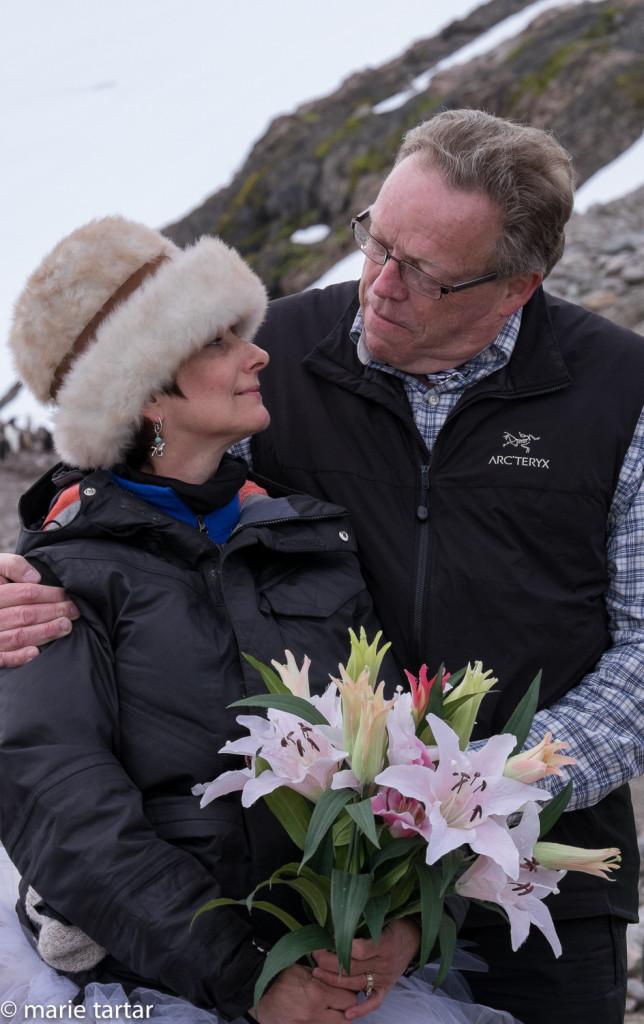
Kevin and Debra, newly married. Immediately after the ceremony, there was an avalanche across the bay
After a group photo, we were turned loose to climb up to observe Gentoo colonies up close.

Gentoo penguins newly returned from the water are resplendently clean, in contrast to their brethren on nests in the colony
Pairs of chicks were being fed by the parent in attendance, the other parent out to sea foraging for the next krill meal to be regurgitated into the growing chick’s expectant mouths.

After foraging at sea and returning with a stomach full of krill, the parent feeds the hungry, growing chicks by regurgitation
There was a snowy, slippery optional climb up to a panoramic viewpoint.
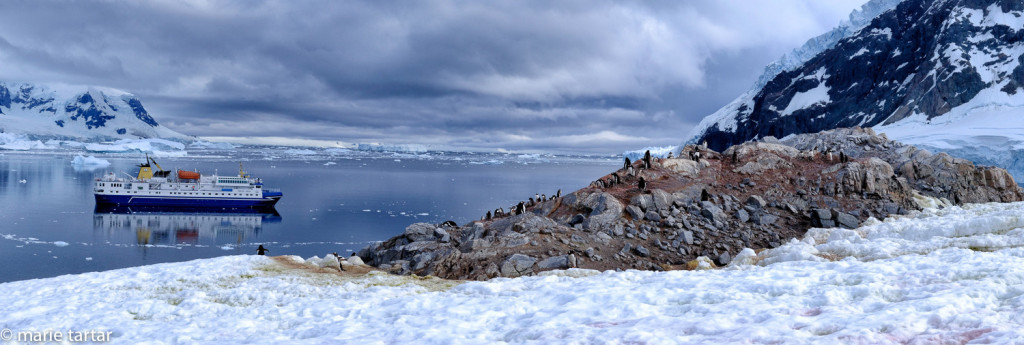
Gentoo colony occupies rocky patch to right; Ocean Nova, our home in Antarctica, can be seen in Neko Harbour
Greg and I climbed up late, while Steve, mindful of his flinchy back, stayed below and captured fabulous close-ups of a Weddell seal in the water.
Friday, February 6, 2015: Deception Island
Deception Island is a horseshoe shaped caldera of an active volcano.
Other than Lemaire Channel, this is the only other site we also visited on our first trip. The name may derive from Spanish, with decepción in Spanish meaning disappointment (presumably of sealers hunting Antarctic fur seals in 1820s). Whaler’s Bay was the site of a whale blubber rendering station, and the site of the first flight in Antarctica in 1928. There was a station-destroying volcanic eruption in 1967, resulting in fumes, a boiling sea, and paint peeling off metal. Additional eruptions occurred in 1969 and 1970. An island within Telefon Bay was observed to have developed over a 24 hour period.
From the ship, Bailey Head appeared too dicey to attempt a landing. During the prior night’s preview, we were shown a recent video of big wave sets pummeling a disembarking boatload, with the zodiac being spun around parallel to the shore, and several passengers being bowled over back into the boat.
Plan B was a visit to Whaler’s Bay, an abandoned whale blubber rendering station, with rusting carcasses of oil storage tanks evoking a Richard Serra installation.
The beach was dotted with landlocked wooden boat hulls, with sand drifts imprisoning the skeletal remains. Whalebones recalled the past life of this lonely place.
Antarctic fur seals defended their territories in the remains of a cluster of wooden-barrel-shaped enclosures. A lone chinstrap penguin held court at the waterfront, surrounded by an adoring paparazzi crowd.
When the tide went out, steam rose from the waterfront, and intrepid “polar plunge” participants began disrobing. Despite injunctions that we’d regret it if we didn’t try it, none of us was tempted into plunging.
The afternoon excursion to Telefon Bay was familiar territory from our prior visit. We climbed to the windy edge of a caldera. The landscape is stark, a dramatic, monochrome wildness.
Sunday, February 7, 2015, our “weather” day, was given over to a daylong seminar featuring the trip’s instructors. It began with a long but entertaining and fascinating presentation by Art Wolfe on his life, career and influences, drawing many parallels between his training as a painter and observer of art history and his photographic work. One especially interesting component of the talk was his images of his extraordinary Japanese garden at his home near Seattle. The day wound up with Christian Fletcher, who kept us laughing at his descriptions of his Photoshop interventions on images, including the “insert bird” tool.
Monday, February 8, 2015: We parted ways with the group, some heading home, while others left for other destinations, including Puerto Natales, Patagonia and Easter Island.
Flying vs. sailing to Antarctica? The advertised “swap 2 days at sea for a 2 hour flight” is great marketing, but definitely oversell. While the flight is 2 hours, that travel day is given over entirely to waiting to fly. The transfer from plane to ship involves traveling fully dressed for Antarctic weather, complete with waterproof rubber knee-high boots (provided by the outfitter), waterproof pants, jackets, gloves and hats. Once the plane touches down on the dirt runway at Frei Station, there are no terminal or restroom facilities, leading to a plane-length queue for the bathrooms before deplaning. Then, a half-hour hike on a muddy and snowy track leads down to the beach, where the zodiacs await the passengers. This route enabled us to avoid the dreaded Drake Passage (which we also skirted on our prior trip, by coming obliquely, from South Georgia), so might be a preferable option for those extremely prone to seasickness.
This trip differed in material ways from our prior trip, but was quite complementary. Although our previous trip was a “Photo” trip with Lindblad and National Geographic, this trip was a smaller group of generally quite serious hobbiest photographers, while the Lindblad trip was more of a mixed bag of interest and skill levels.The difference between the 2 groups was demonstrated on our early morning Lemaire Channel cruise, with virtually everyone up and on deck on the Ocean Nova, despite the cold and early hour. In contrast, the Lindblad boat, which we passed in the Channel during that sweetly pastel sunrise, was characterized by Kevin and Michael as a “ghost ship,” passing through incredible scenery in wonderful light, with hardly anyone on deck.
As a boat, we preferred the National Geographic Explorer boat to the Ocean Nova. The Ocean Nova was comfortable enough, but the Lindblad boat and cuisine were definitely more luxurious. Reading a description of the accommodations researcher David G. Campbell shared with 2 engineers on an overcrowded Brazilian Navy supply vessel in his 1992 book The Crystal Desert put the minor differences in sharp perspective:
“We live in a claustrophobic world stripped of privacy, a realm of competing stereos, humid bath smells, a pall of cigarette smoke. You have to close the lid on the head before pumping the flushing mechanism, else it burps in your face. The grubby brown pile carpet is constantly damp with burp water. I sleep, wrapped in wool blankets, on a sofa that is impregnated with engine oil and cigarette ashes.”
Thankfully, this wasn’t our experience at all!
The other material difference between our 2 trips was the timing. Traveling during different months of the Antarctic summer significantly influences what one sees. Our prior trip (which also included a few days in the Falkland Islands, South Georgia and the Orkneys) was during November (we celebrated Thanksgiving aboard), much earlier in the season. Penguins were reconnecting with their mates, their calls somehow distinguishable among the cacophony of their brethren similarly occupied.

Penguins can locate their mates and chicks by their distinctive calls, even in the cacophonous midst of a colony
There was much mating activity and nest building, and we saw many penguins on eggs, but relatively few chicks. By going later in the season in early February, we saw many more chicks of varying size, hungrily feeding in the rush to grow and molt before the end of summer. The downside is, penguins have been ensconced for months, and their colonies reek of guano.
The Ocean Nova wasn’t filled to capacity, as these Antarctica XXI trips are limited in numbers by the aircraft capacity. We did like being with a smaller group, which translated into shorter lines while fully suited up, waiting to board the zodiacs (our Lindblad trip had about 110 passengers). This group was remarkably congenial and diverse, and quite international, with people hailing from Australia, New Zealand, Bali, Bangkok, Calgary and every point in between. We enjoyed the company, the delightfully sharp and unending supply of gin and tonics from the open bar, and learned a lot about new destinations and photographic techniques from our traveling companions and the stellar group of photo pros, many of whom we hope to travel with again on their home turf. While we were sad when our Antarctic stay ended (it felt a day too short to me, at 4 full days), for Greg, Steve and me, this meant we were off to discover the lure of another iconic land, Patagonia, subject of the prior post.
-Marie
P.S. For more Antarctica images, don’t forget to visit the galleries section to see Steve’s images (under Natural Wonders). Here’s a link:
To see more of our images, click on this link


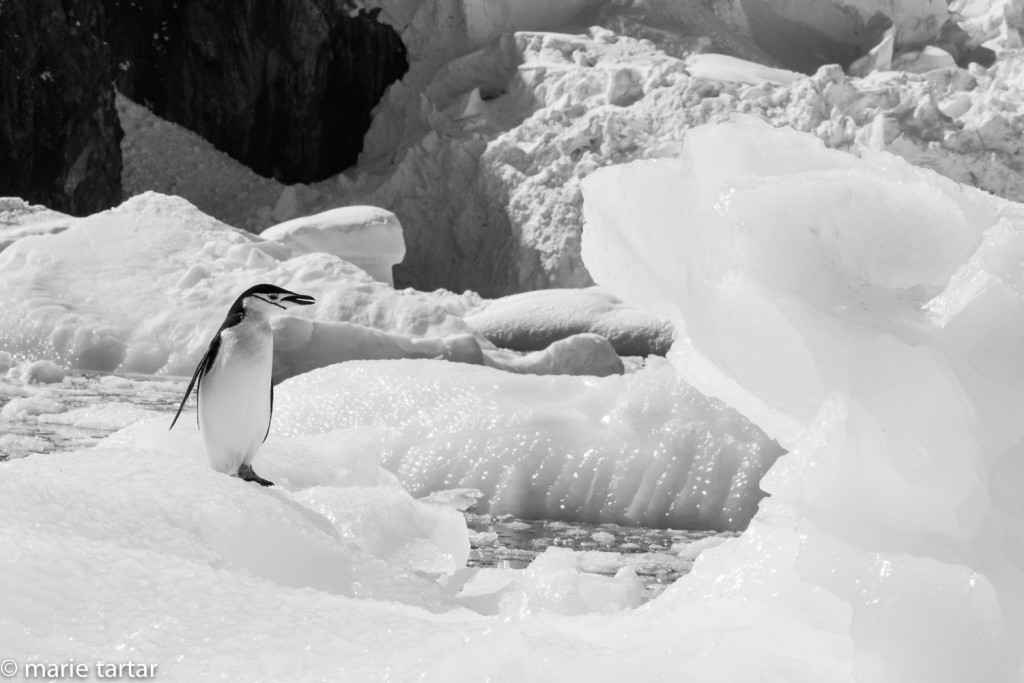
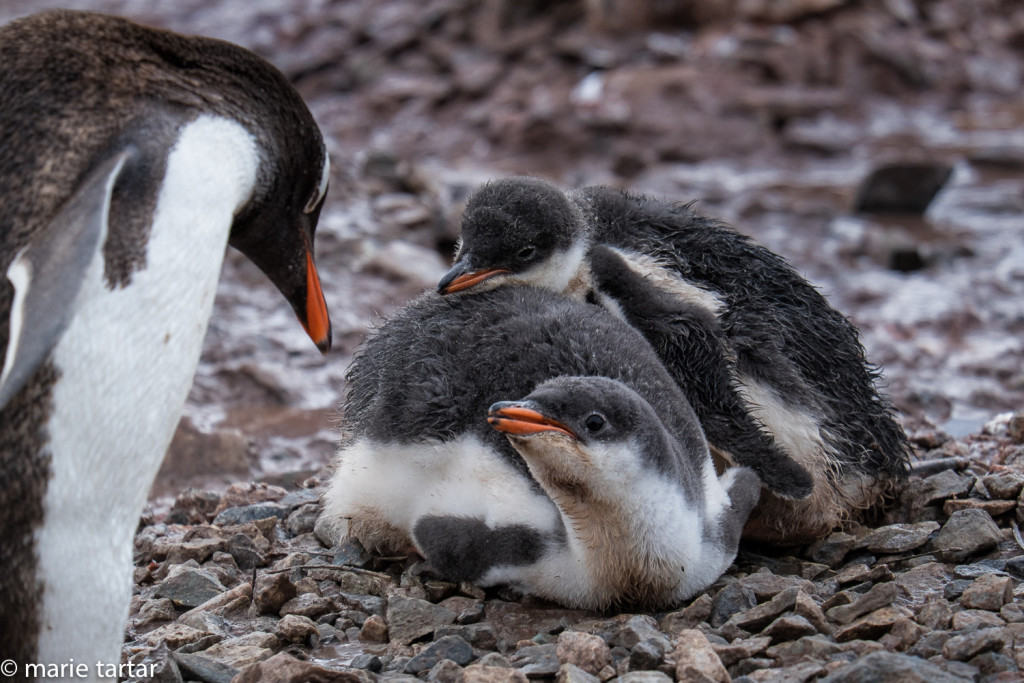
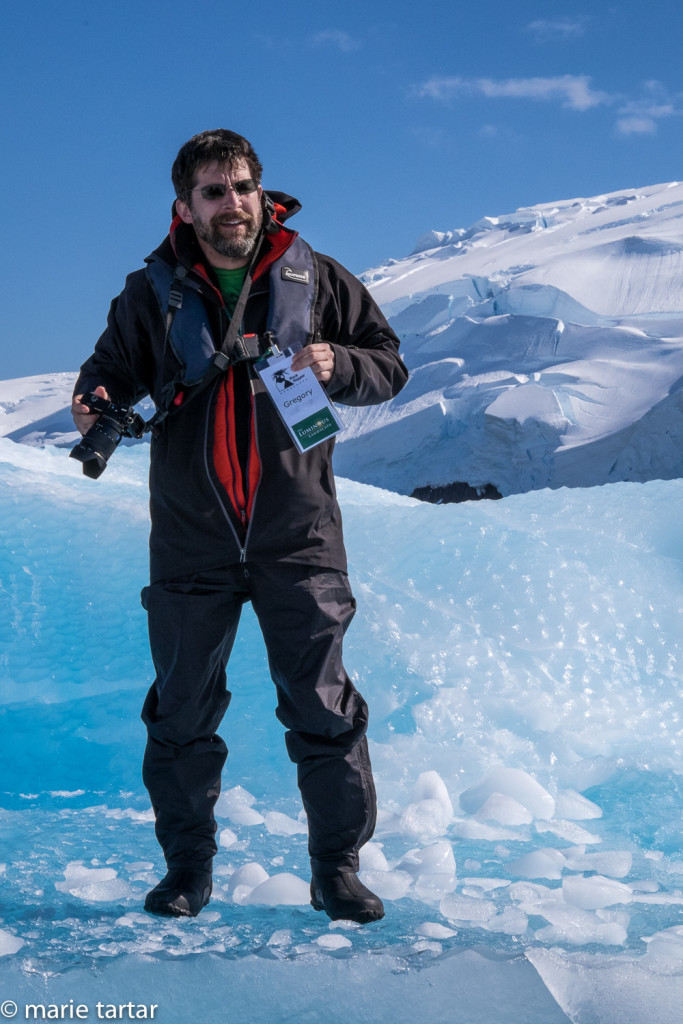

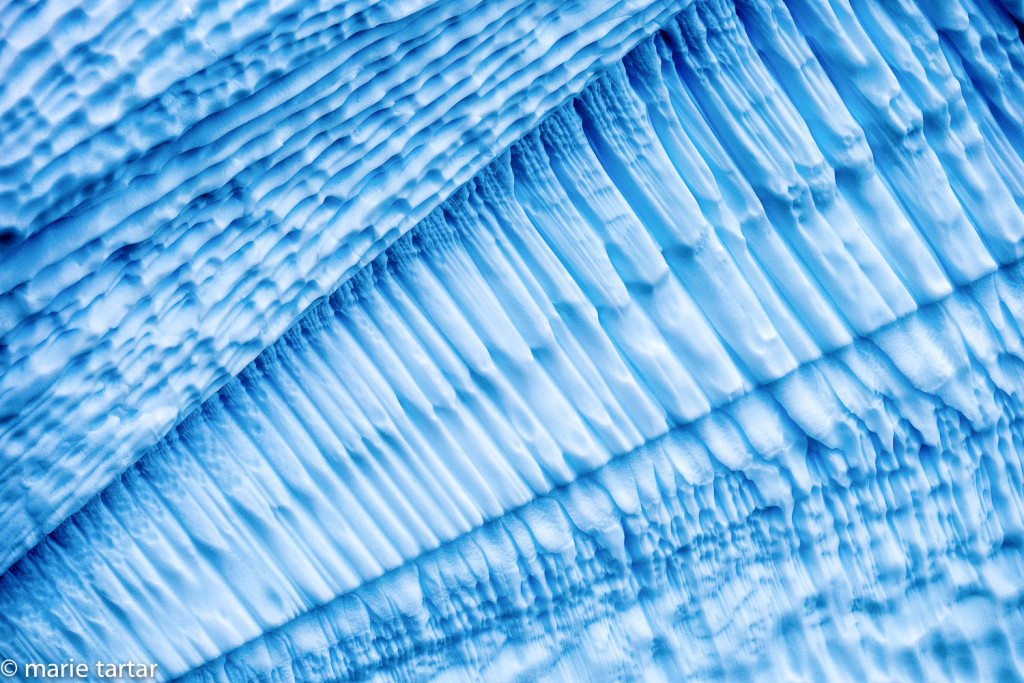

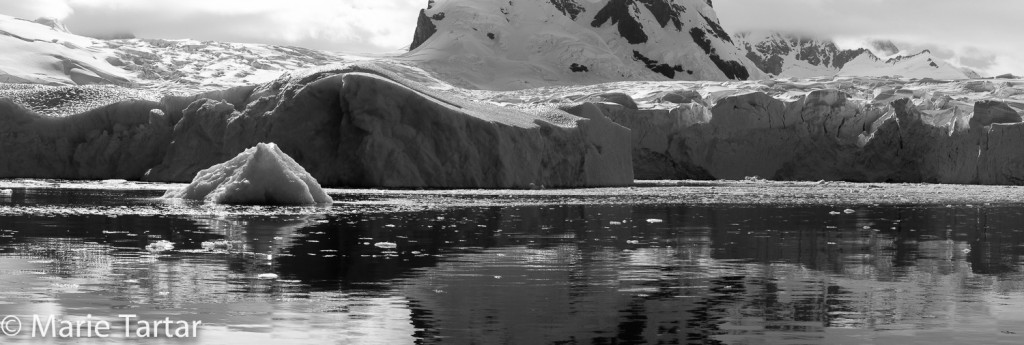


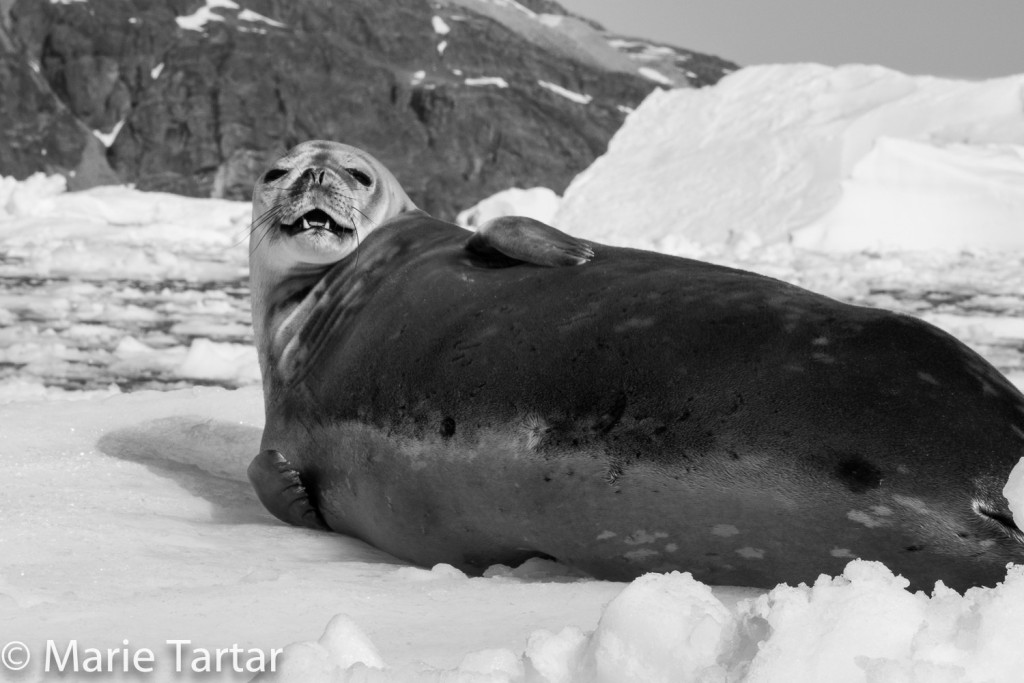


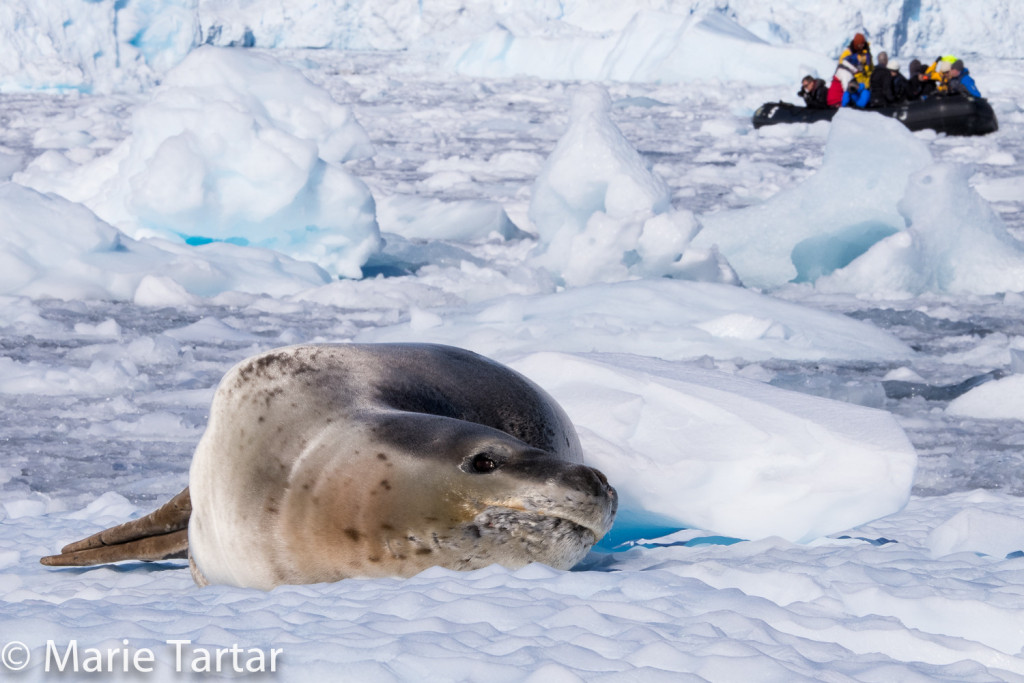

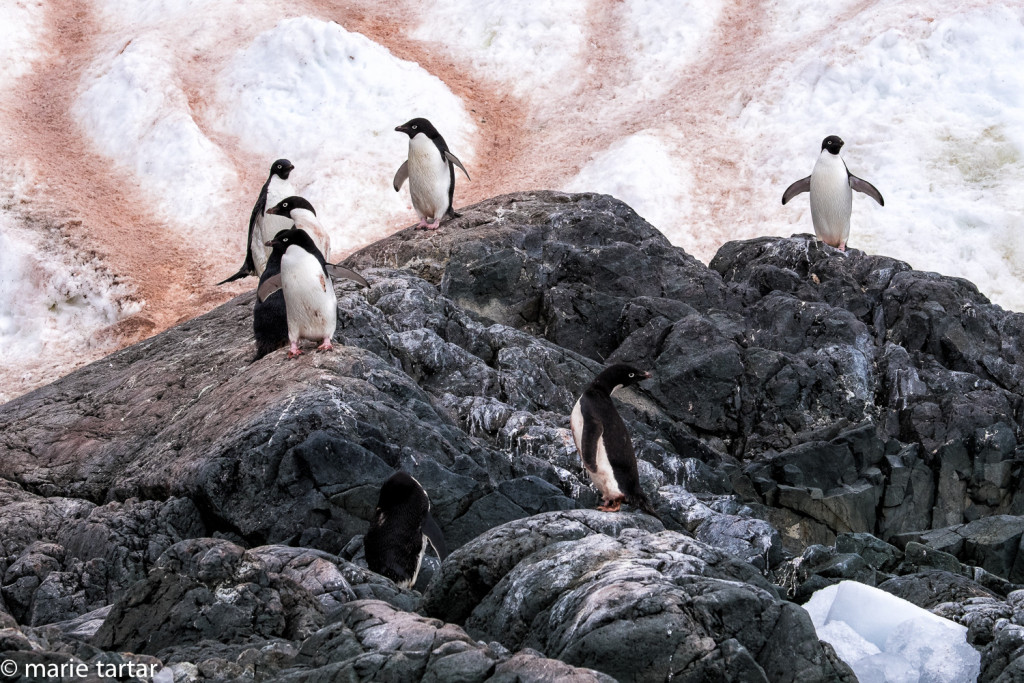

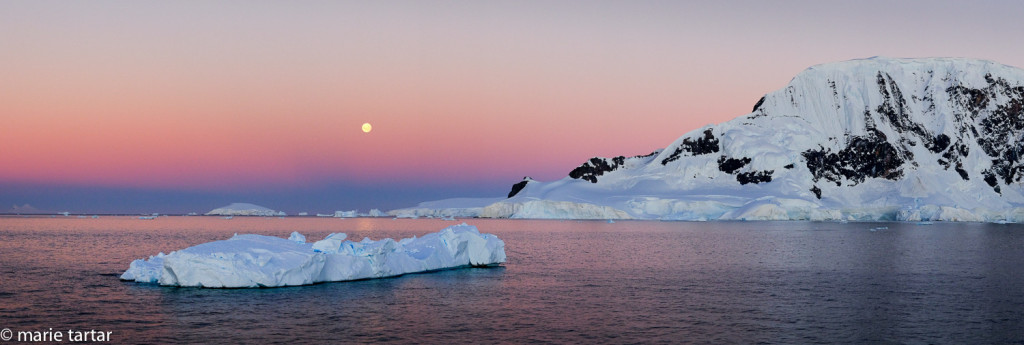
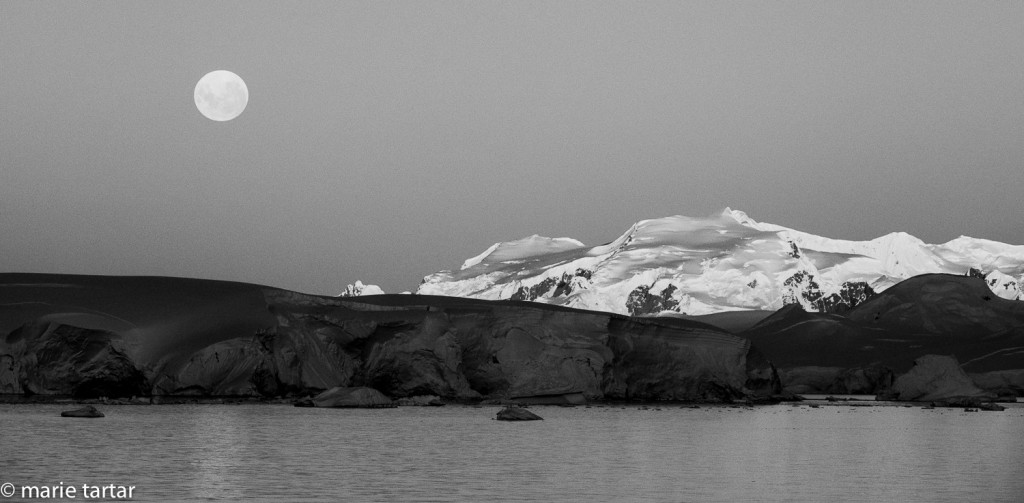
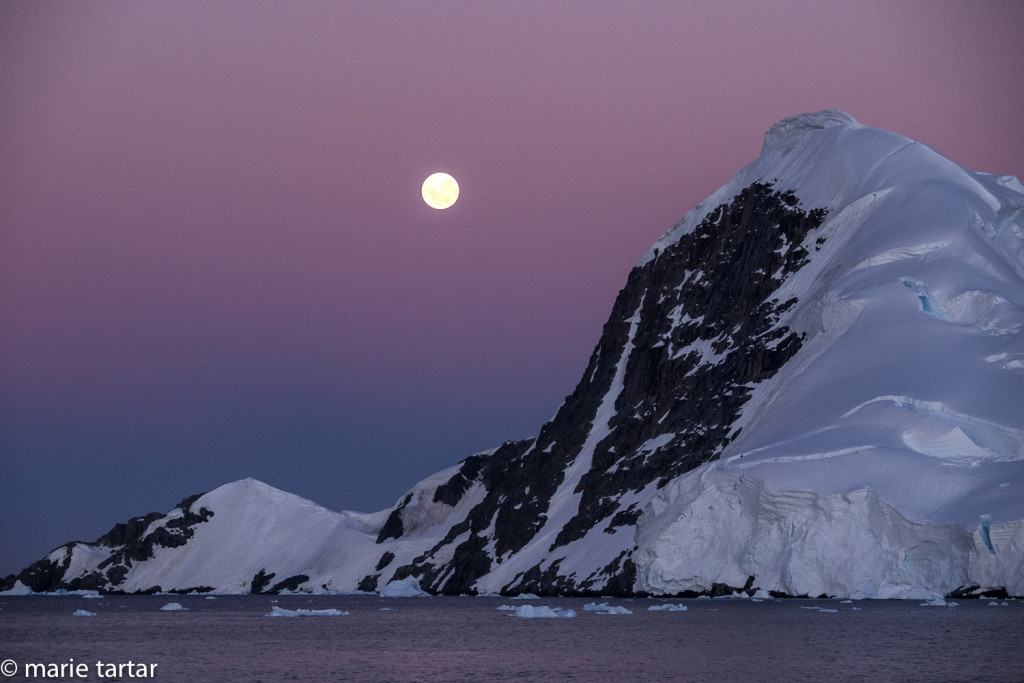
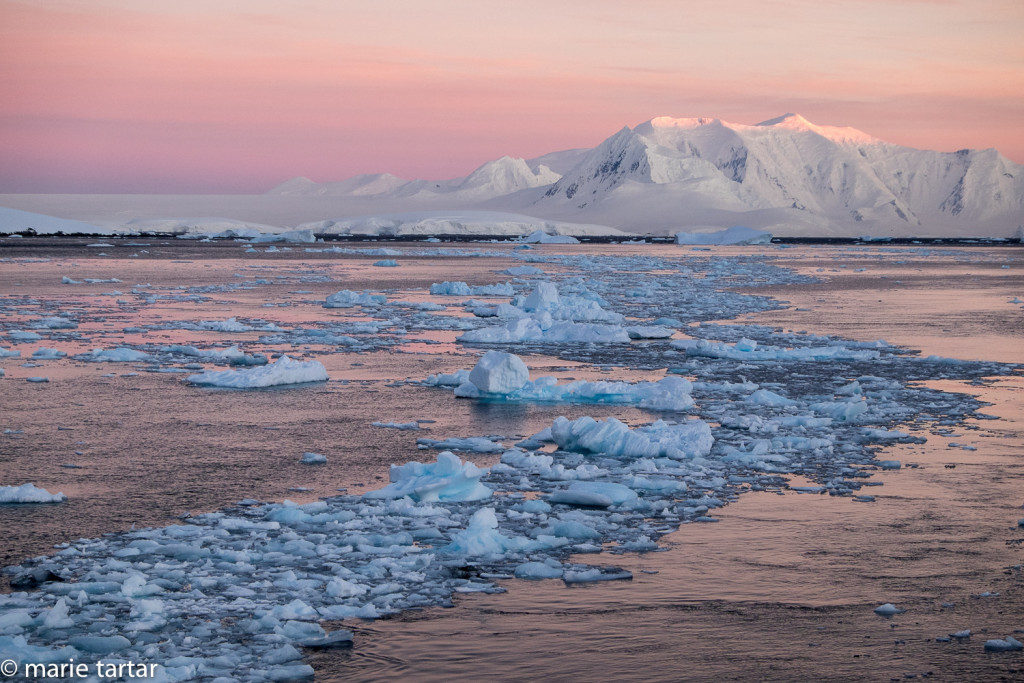
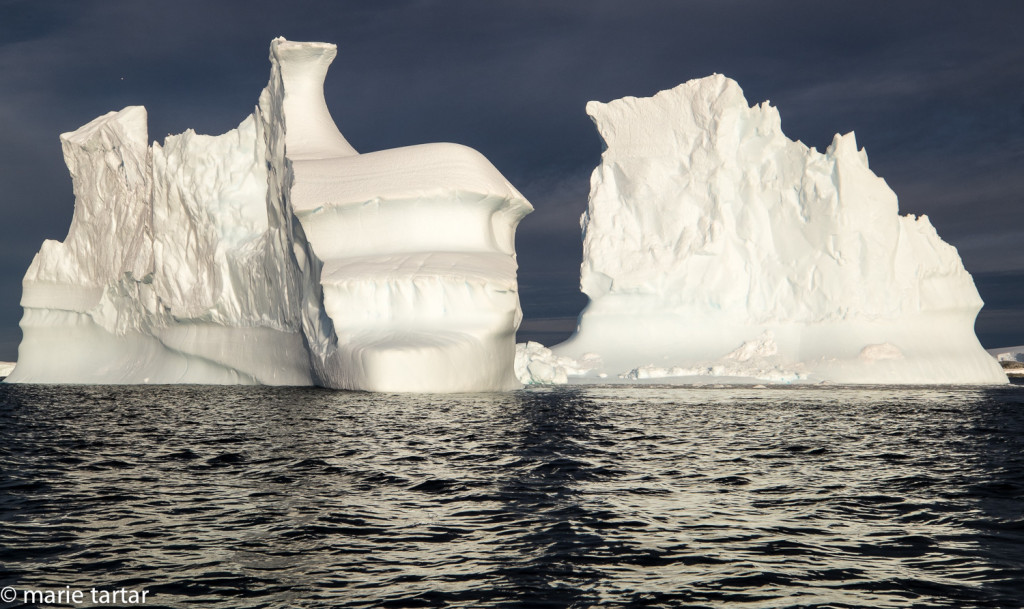

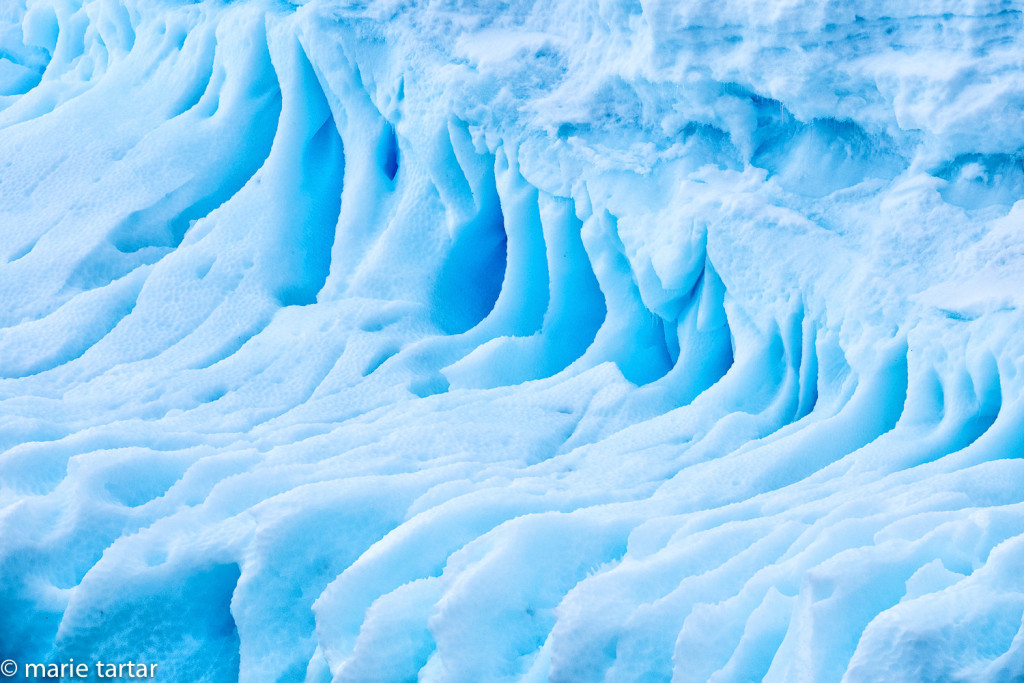
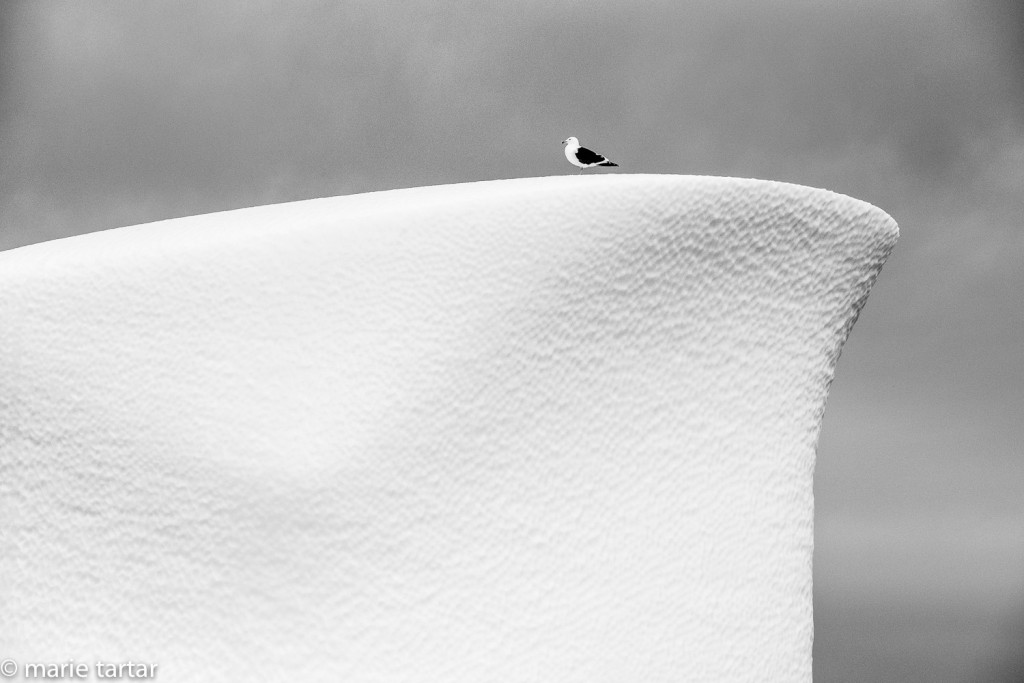
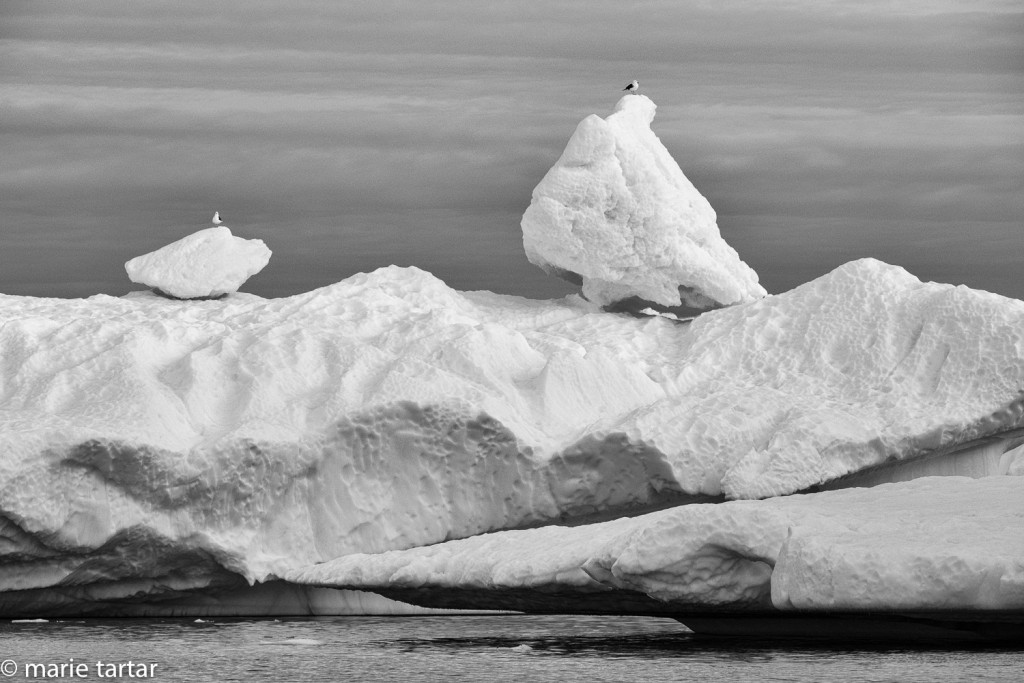

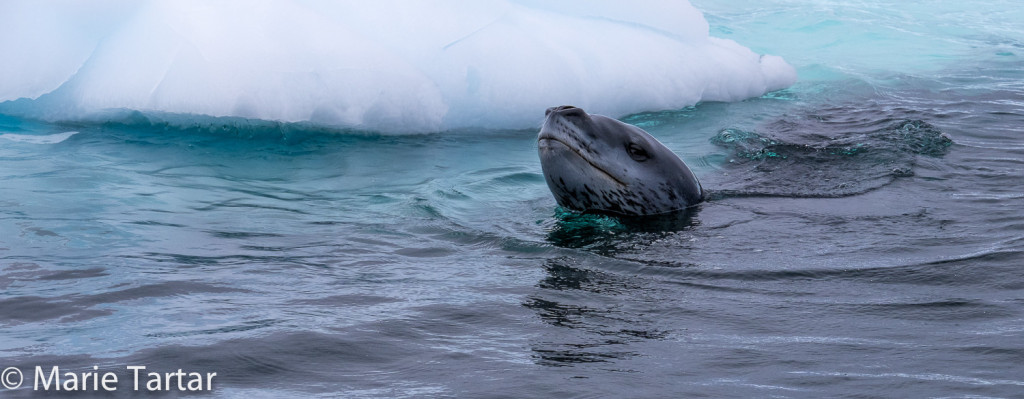
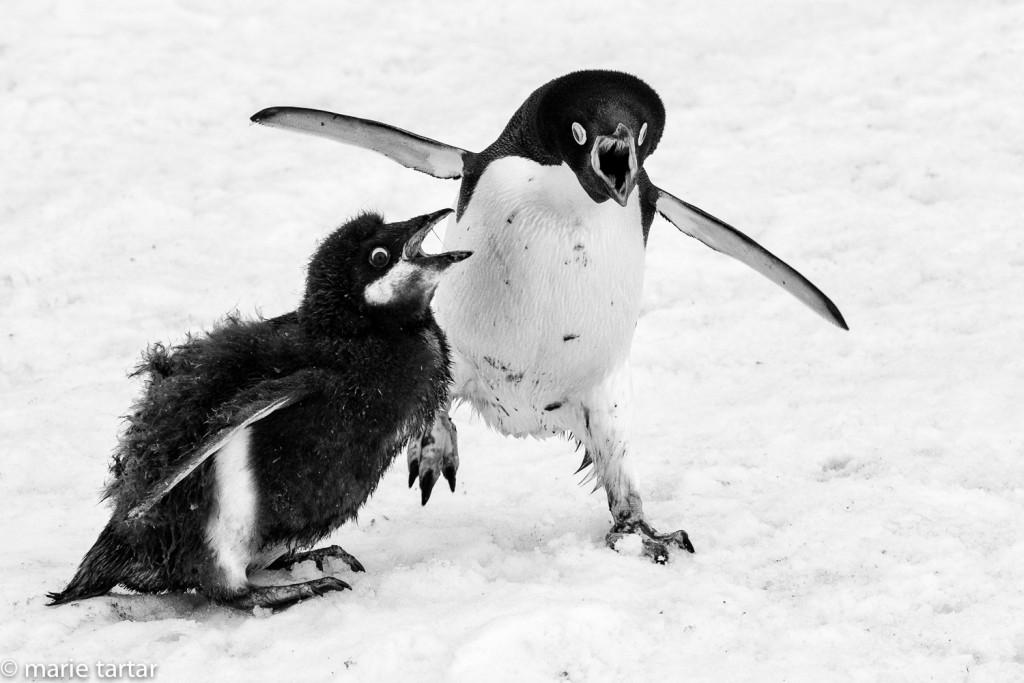
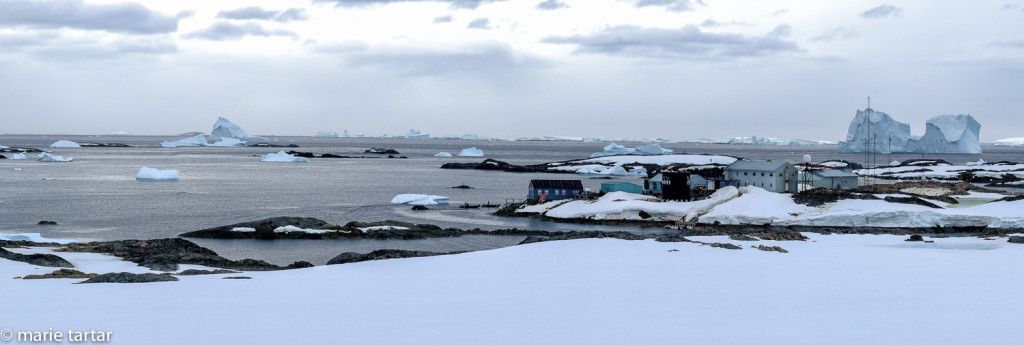



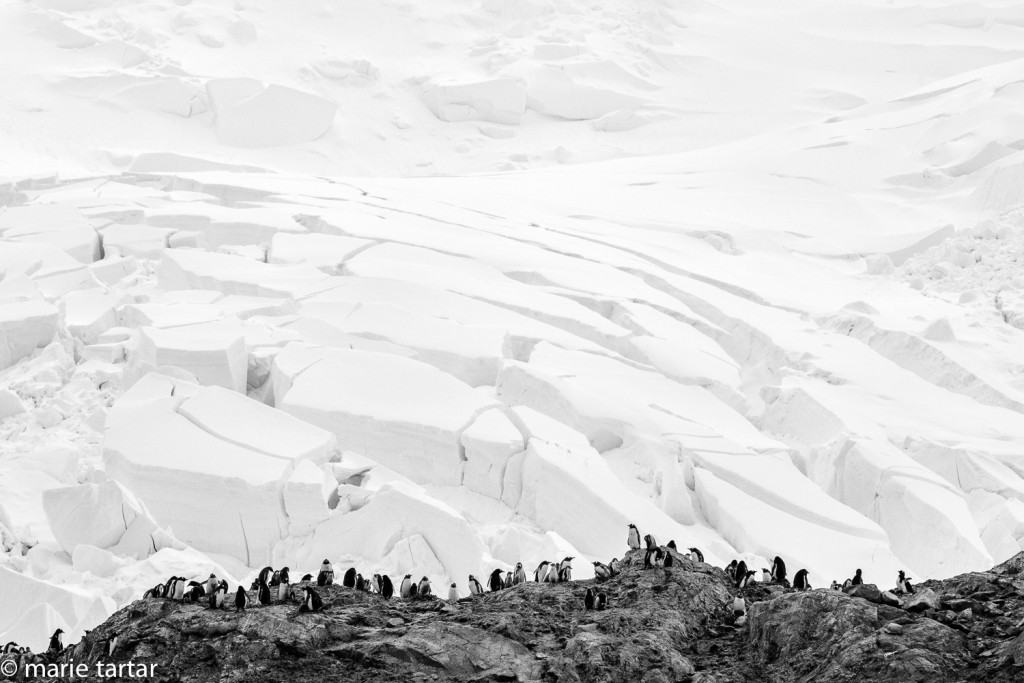
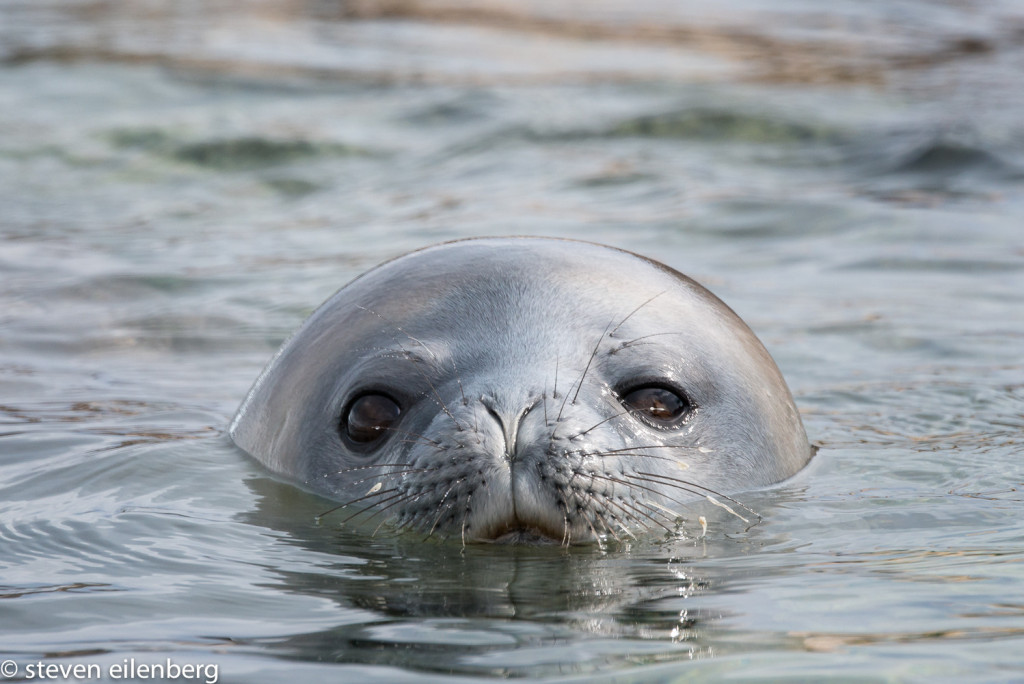


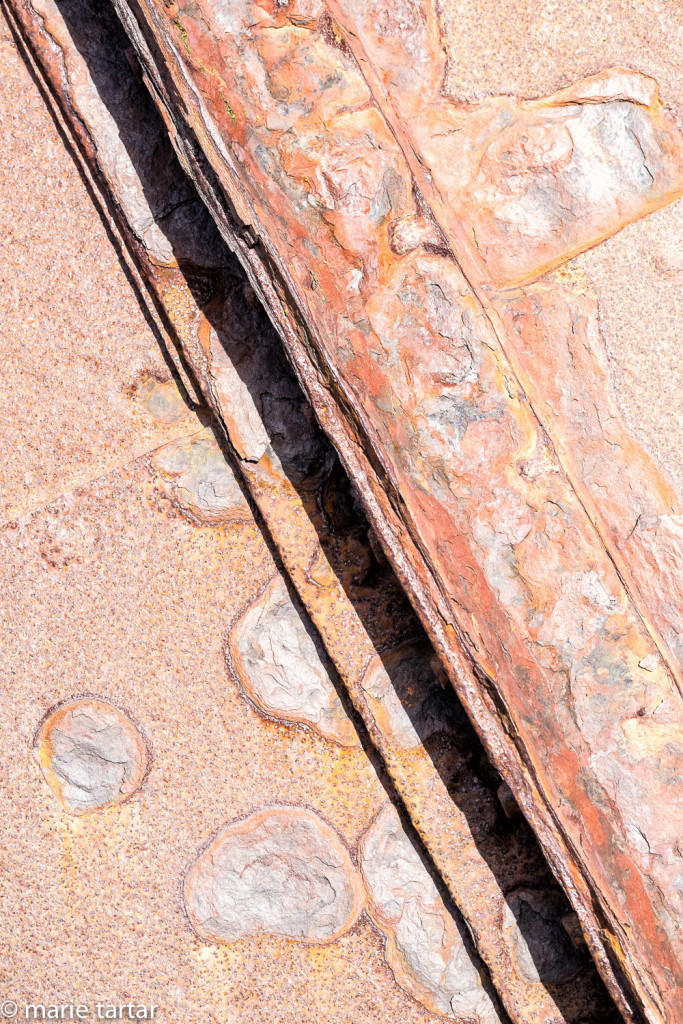
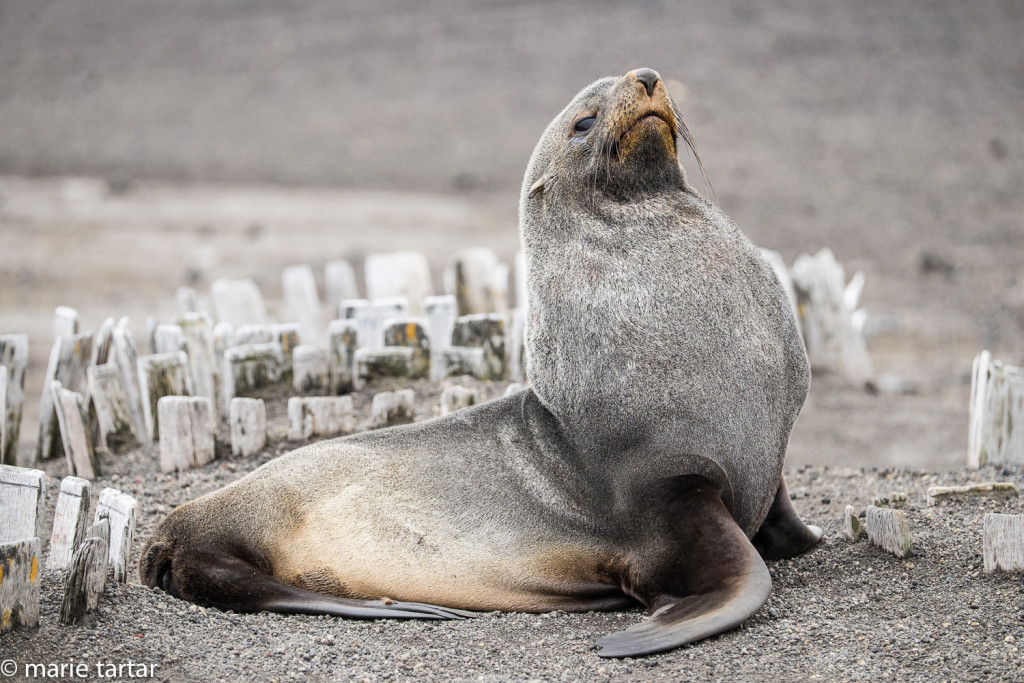
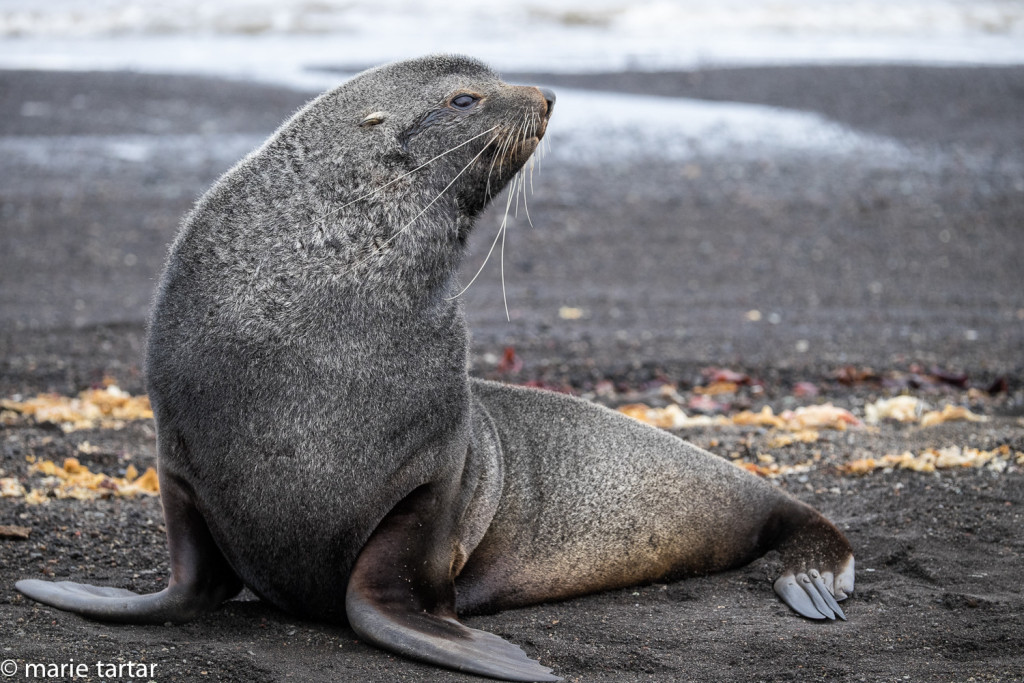

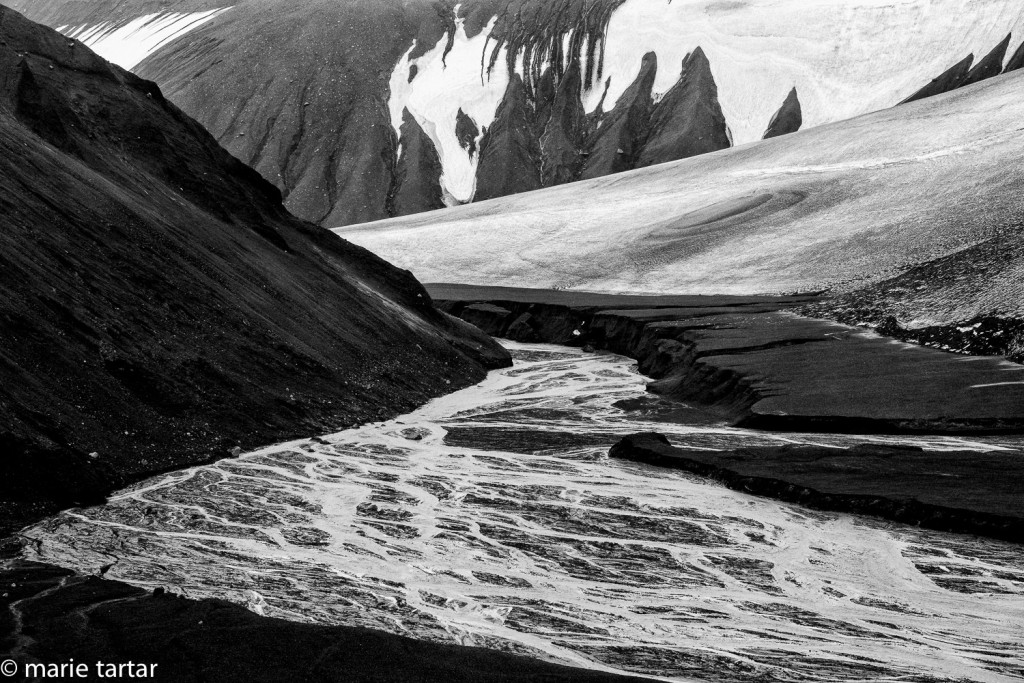

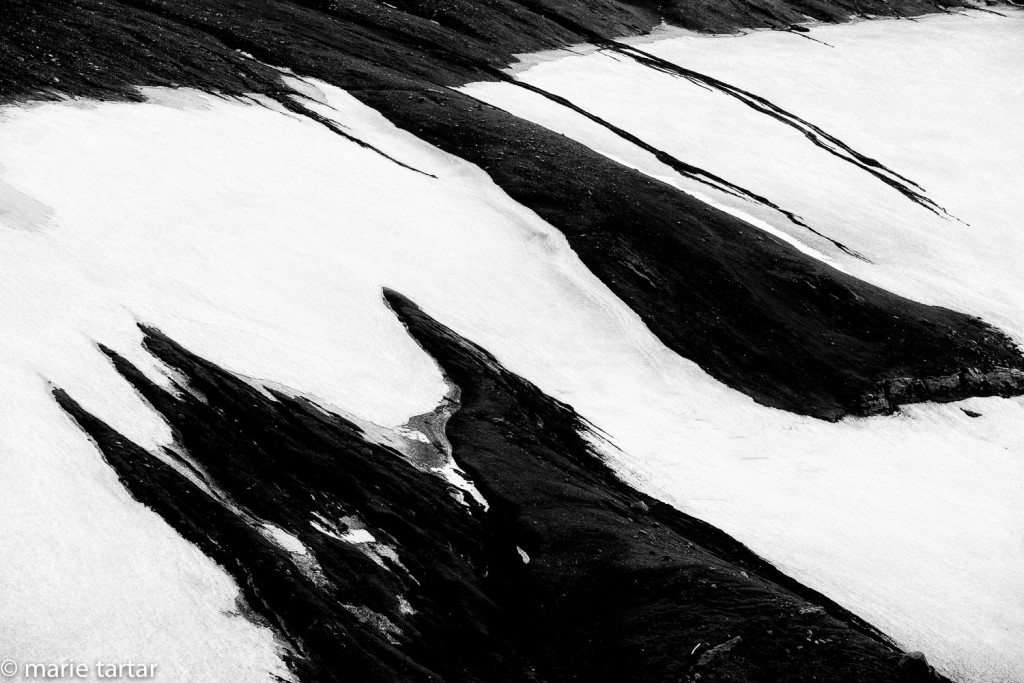
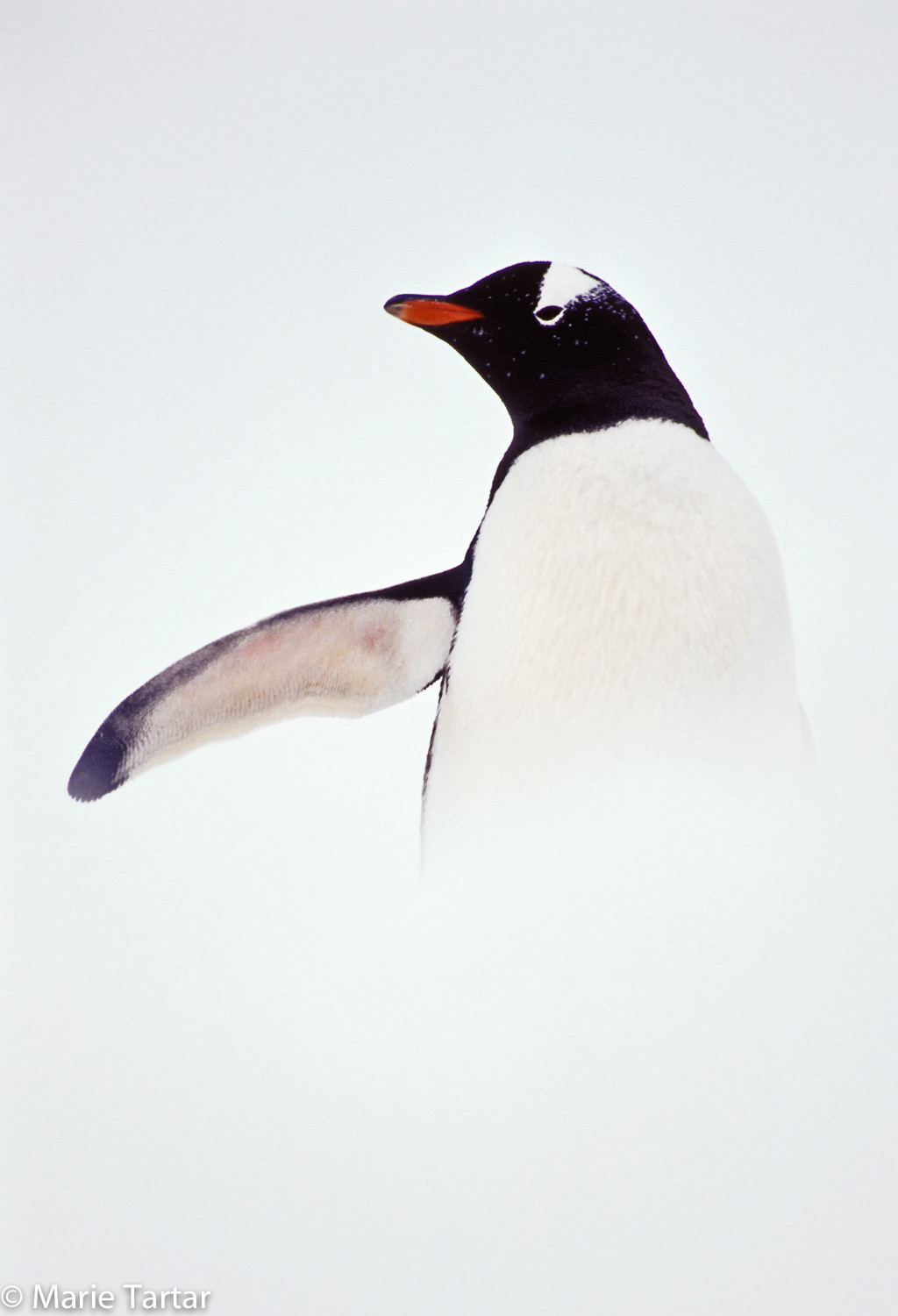
Amazing photos! Love the cool colors of the icebergs and the actions shots of the penguins. Congrats on 25 years!